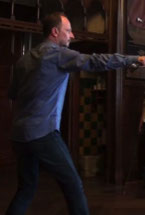Constructing the intensity – DYNAMICS vs. TIMING
(V1bT4)
The sword exercise session described above (V1bT3) was highly informative. Although I decided not to pursue any further sword studies, I could implement several findings from the session directly into my playing.
One of the common features in handling the sword and violin bow is the structure of the sequences and phrases respectively. Both the repetitive clashes of the sword, and the bow action reveal metrical structure, and they both demand intensified action toward its culmination. Bound by the metrical structure, the intensification in a musical phrase is constrained by the temporal framework, so the intensity cannot imply speeding up or slowing down the actual tempo.
In the video example (vid.1) I compare two strategies of intensifying a musical phrase. While a Soundist may intensify the phrase by increasing the volume (crescendo), a Gesturist will engage in body movement with the aim of intensifying the timing. Neither of these strategies can remain strictly in their own domains of sound or time respectively. In order to increase the sound, the Soundist will need to extend the body movements. Similarly, the Gesturist’s assimilation of the energetic sword fighting movements will also translate into sound as a crescendo.
Can I detect the origins of the perceived intensity? Can I distinguish between the crescendo that happens as a consequence of the gestural action and that which is simply conceived as a crescendo?
Vid. 1 Comparison: Intensity of sound vs. intensity of timing.
The idea of creating the intensity through timing based on body movements occurred to me during the video analysis of the sword session. Each position of the sword ('prima', 'seconda', 'terza', and 'quarta') also triggered a response in my posture.




Ex. 1 The initial steps in embodying the sword positions ('prima', 'seconda', 'terza', and 'quarta').
Even though I exercised the movements slowly, I noticed how important it is to shape the energy of the body movements when passing from one posture to another. Similarly, in a bow action, the energetic shaping of the movements in the trajectory connecting the four postures (accents) will accumulate the energy into a final culmination.
To conclude, in the experimental study based on the sword exercise session, I compared two strategies for achieving intensity in a musical phrase, one relying on the dynamics of the sound, the other employing body movements in order to intensify the timing. Each strategy proved to be efficient in its own domain. The Soundist achieved more of a culmination in the resulting volume, while the Gesturist communicated the sword fighting through expressive gestures. But if I focus closely on the issue of the intensity of the phrase, the gestural timing proved to generate a more palpable culmination than the one based on dynamics.